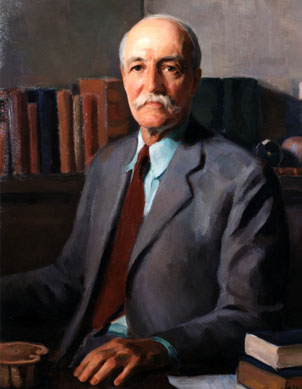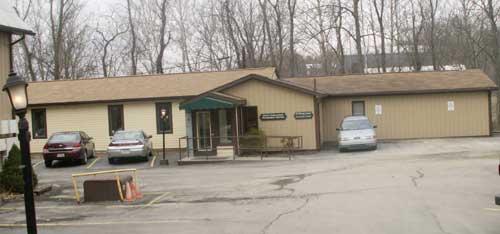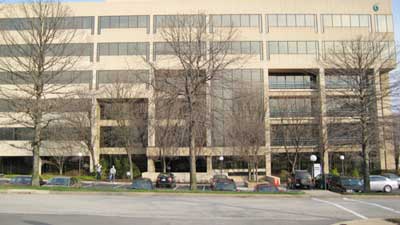
It was on June 27, 1923, that Governor Gifford Pinchot signed into law Act 331 (Public Law 858) creating the Pennsylvania State Employees’ Retirement System (PennSERS).
Since that time, PennSERS board members and staff have worked together – along with our colleagues in the legislature and various administrations – to help ensure the health and stability of the system so that the hundreds of thousands of members and participants we have served over the years could look forward to a financially secure retirement.
It’s been quite a ride.
Act 331, signed into law (Public law 858) by Governor Gifford Pinchot, established SERS.
 The law required 25 years of service for a member to be “vested” in the system or eligible for monthly pension payments. Today, members must work either five or 10 years, depending on their class of service, to be vested in the system.
The law required 25 years of service for a member to be “vested” in the system or eligible for monthly pension payments. Today, members must work either five or 10 years, depending on their class of service, to be vested in the system.
In its first full year in operation, SERS had 1,822 members. Contributions begin 1/1/1924.
 Bureau of State Retirement is moved to the Treasury Department from the Department of State. The State Treasurer serves as Chairman of the board.
Bureau of State Retirement is moved to the Treasury Department from the Department of State. The State Treasurer serves as Chairman of the board.
Bureau of State Retirement is returned to the Department of State and the Secretary of the Commonwealth serves as Chairman of the board.
The retirement enabling law is rewritten and established. Many sections and provisions are added to bring the law into conformity with all provisions.
Act 230 granted the first Cost of Living Adjustment (COLA) effective July 1; average increase for annuitants was 6.76%; the supplemental retirement program titled Social Security Integration was first offered to members.
Act 87 allows the fund to invest up to 10% of assets in preferred and common stock.
Act 31 re-codified the State Employees' Retirement Code: the State Employees' Retirement Board became an "independent administrative Board"; a COLA was granted, with the average increase of 23.3%; stock investment authority was increased to 25% of Fund assets.
A COLA was granted with the passage of Act 130; average increase: 25%. A formal investment policy statement was adopted by the SERS Board*.
Act 66 was signed, establishing the Public Employee Retirement Study Commission to study public employee retirement and pension systems.
Act 45 signed, providing for an annual independent audit, allowing 50% of investments of the fund to be in stocks, and allowing real estate investments; Act 67 signed, increasing the SERS Board from seven to 11 members.
Act 31 increased the employee contribution rate from 5% to 6.25% of salary.
Assets in the fund totaled $4 billion.
To comply with a 1983 U.S. Supreme Court Decision titled “Norris versus Arizona”, pension plans throughout the U.S. adjusted their actuarial factors to be gender neutral. As a result of the Norris decision, SERS adopted "Blended" or Gender Neutral Actuarial Tables for members who first joined the plan after the Norris Decision became effective, August 1, 1983 . A new set of actuarial tables was developed for the System that made the necessary adjustments required by the Norris Decision for those members who joined the System prior to August 1, 1983. The old actuarial tables were retained for member's service prior to August 1, 1983. They were deemed "Sex Distinct Actuarial Tables.”
Act 95 signed, opening a special one-year "30 and out" early retirement provision effective July 1, 1985, for eligible members with at least 30 years of creditable service and granting a COLA, the average increase of which was 9.94%.

SERS opened its first regional office in Montoursville.
Assets in the fund at year end totaled $6.2 billion.
Act 91 extends the "30 and out" retirement window from July 1, 1986, to June 30, 1987.
Assets in the fund at year end totaled $7.1 billion.
Act 69 extended the "30-and-out" retirement window from July 1, 1987, to June 30, 1989; Act 81 signed, authorizing the establishment of a Deferred Compensation Program for officers and employees of the Commonwealth, with the SERS Board assigned to implement and administer the program. Seneca regional office opened.

Act 112 signed, granting a COLA effective with the first annuity payment after January 1, 1989; the average increase was 9.5%; the Act also extended the "30 and out" retirement window from July 1, 1989, to September 30, 1991.
Assets in the fund at year end totaled $8.3 billion.

Wilkes-Barre Regional Office opened.
Assets in the fund at year end totaled $9.8 billion.

Bensalem regional office opened.

Pittsburgh regional office opened.
Act 23 was signed, granting an additional 10% service credit to certain members retiring in 1991. Resulted in triple the workload of normal years. The Act also officially shifted responsibility for member retirement counseling from the individual State agencies to SERS and extended the "30 and out" retirement window from October 1, 1991, to June 30, 1993.
Assets in the fund at year end totaled $11.9 billion.
SERS reached fully funded status.

State College regional office opened.
 Harrisburg regional office opened, completing the network of regional offices across the state.
Harrisburg regional office opened, completing the network of regional offices across the state.
Assets in the fund at year end totaled $12.5 billion.
Act 183 signed authorizing the spouse of a deceased retiree the opportunity to purchase State group health coverage. This coverage provides the same hospital and medical benefits that the spouse had prior to the death of the retiree.
The member contribution rate decreased from 6.25% to 5% of salary for all regular class members.
Assets in the fund at year end totaled $13.7 billion.
Act 29 applied the "prudent person" standard of investment authority to the SERS Board; granted a COLA to eligible annuitants, the average increase of which was 6.48%; extended the "30-and-out" retirement window from July 1, 1993, to July 1, 1997; and allowed active members who returned to service from retirement to eliminate the frozen present value on their benefit if they work three or more years after their return to service.
Act 77 signed, limiting retirement-covered compensation to $150,000, effective January 1, 1996.
Assets in the fund at year end totaled $16.3 billion.
Act 167 signed, providing a special supplemental post-retirement adjustment to members who performed certain military service and retired after February 28, 1974, and before January 1, 1985.
Assets in the fund at year end totaled $18.5 billion.
For the first time, annual benefit payments to retirees and their survivors and beneficiaries topped $1 billion; total fund assets at year-end: $21.3 billion.
Assets in the fund at year end totaled $21.3 billion.
Act 41 signed into law, reopening the "30 and out" retirement window from July 1, 1998, to June 30, 1999; Act 88 signed into law, granting a COLA to eligible retired members based on the date of retirement up to and including June 30, 1997.
Assets in the fund at year end totaled $28.1 billion.
Effective January 1, 2000 , Act 12 provides for mandatory membership in SERS of designated county-level court administrators, their designated deputies, associates, assistant administrators and special court administrators within the State judicial personnel system. In addition, Act 12 provided for court employees’ compensation by the Commonwealth and allowed them to convert their county service to State Service.
Act 9 reduced the vesting period for all current SERS members from 10 to 5 years. Act 9 created two new classes of service, Class AA and Class D-4. All employees hired after July 1, 2001, excluding State Police, legislators, judges, or district justices, will be Class AA when they join SERS. Legislators elected after July 1, 2001 will be Class D-4 when they join SERS. Act 2001-9 extended the election period for electing Multiple Service to 365 days after becoming an active contributing member. Previously, the election period was 30 days of becoming an active contributing member. Act 9 also opened a window to allow all active contributing members who otherwise would be eligible to elect Multiple Service to make a Multiple service election on or before December 31, 2003.
On January 1, 2002, SERS switched from using the 1971 Group Annuity Mortality (GAM) tables to calculate benefits, to the GAM 1983 tables. Act 38 provided specific plan administration provisions and granted a two-phase COLA for annuitants. The average increase was 13.860% in 2002, and 6.99% in 2003.
Act 40 changed the funding period for most, but not all, of SERS’ actuarial liabilities from 10 years to 30 years, effectively spreading out the payment of SERS’ costs and liabilities. In essence, Act 2003-40 has refinanced the pension mortgage from a 10-year term to a 30-year term. The floor contribution rates have also been changed to require increasing minimum employer contributions of 2%, 3%, and 4% through fiscal year 2006-07.
April 2003 – July 1, 2005 - A period of unprecedented customer service activity triggered by the negotiations and agreement reached between the American Federation of State County and Municipal (AFSCME) and the Commonwealth. The agreement resulted in a 30% increase in retirements. Health insurance eligibility and program provisions were the primary motivating issue.
Act 2007-8 established a permanent employer contribution rate floor of 4%. Nearly a year's worth of retirement applications were submitted to SERS for a June retirement date. Health insurance eligibility and program provisions were the primary motivating issues in the increased number of retirements. After a fifth year of exceptionally strong investment returns, the SERS Fund hit an all-time year-end high of $35.5 billion.
Assets in the fund at year end totaled $35.5 billion.
As a result of the global economic collapse that affected virtually all institutional investors, SERS suffered an investment loss of 28.7%. The investment return was within one percentage point of the median return for large public pension funds and a net loss of $11.1 billion to the fund.
Assets in the fund at year end totaled $22.8 billion.
Although the economic downturn continued into the first quarter of the year, the SERS fund recovered strongly over the remainder of the year, earning a one-year return of 9.1%, exceeding its 8% long-term assumed rate of return. Despite this, the adverse effects of 2008 continued to weigh on the fund and inspired a new round of pension reform discussion.
In addition, SERS began notifying members by letter when they reached “vested” status in the system (when they are eligible for monthly pension payments, even if they will be reduced for early retirement) and when they reached normal retirement age for their class of service in the system (entitled to a pension that is not reduced for early retirement).
Act 2010-120 created the A-3 and A-4 classes of service in the pension system and reduced retirement benefits for most employees hired on/after Jan. 1, 2011, by reducing the accrual rate to 2%, increasing retirement age to 65, extending vesting period to 10 years, prohibiting the withdrawal of member contributions and interest upon retirement, and other measures. The legislation also set most benefit provisions of new legislators at the same level as rank-and-file employees. Act 2010-120 also retained the employee contribution rate of 6.25% and created the opportunity for employees to "buy up" to a 2.5% multiplier in exchange for a higher employee contribution. The law also created a provision by which employee contributions could increase in certain circumstances if investments fail to perform as expected and employers meet their payment obligations, referred to as “shared risk.” The law also refinanced pension system liabilities and capped growth of employer contribution rate increases.
Assets in the fund at year end totaled $25.9 billion.
Assets in the fund at year end totaled $27.4 billion.
Act 2017-5 created the A-5 and A-6 classes of service in the pension system and fundamentally changed the retirement benefit for most new employees beginning Jan. 1, 2019. The law established a Defined Contribution Plan, in which a member’s retirement benefit comes from an individual investment account. It also created a “hybrid” plan, in which a portion of the member’s retirement benefit comes from a defined benefit pension and a portion comes from a defined contribution individual investment account. The law also added a “shared-risk/shared-gain” provision for members of the new A-5 and A-6 classes of service. According to the provision, the members’ contribution rate (as a percent of pay) may change by 0.75% every three years and by no more than 3% overall depending on the performance of the SERS Fund.
The law also made two enhancements to the benefit structure for members of the A-3 and A-4 classes of service. It allowed members in the A-3 and A-4 classes to elect lump sum withdrawals of their contributions and interest at retirement, like members in other classes of service in the system; however, the withdrawals would have a greater impact on members’ remaining annuity. It also added a “shared-gain” provision by which members’ pension contributions could go down when SERS Fund investment returns exceeded return targets. According to the provision, the members’ contribution rate (as a percent of pay) may change by 0.5% every three years and by no more than 2% overall.
The law also changed the method for calculating the normal cost of benefits beginning with the Dec. 31, 2021, actuarial valuation of the system; directed that savings from the legislation be captured and dedicated to paying down the pension system’s unfunded liability in the form of unfunded liability contributions; and established the Public Pension Management and Asset Investment Review Commission to study the performance of current investment strategies and procedures.
Assets in the fund at year end totaled $29.4 billion.
Jan. 1, most of the commonwealth’s new hires are automatically enrolled in the new Hybrid Plan created by Act 2017-5, in which a portion of the member’s retirement benefit comes from a defined benefit pension and a portion comes from a defined contribution individual investment account. The new hires contribute a total of 8.25% of their pay toward their retirement benefit, which is split between the two plans, with 5% going toward the pension portion of their benefit and 3.25% going toward the investment account. The new hires have 45 days in which to elect to stay in that hybrid plan in the default class of service, or elect to:
• Switch to a different class of service with different contribution rates (combined rate of 7.5% of salary, split between the two plans with 4% toward the pension component and 3.5% toward the investment account component)
• Forgo the traditional pension component of those plan options and participate exclusively in the Defined Contribution Plan and contribute 7.5% of their pay toward their investment account
Assets in the fund at year end totaled $31.1 billion.
Jan. 1, added the Retirement Solutions Group to our participant service team to provide guidance and advice regarding SERS’ individual investment plans – the Defined Contribution Plan and the Deferred Compensation Plan – at no additional cost. Representatives from the group are trained, licensed, and may act as a fiduciary to participants of the plans. The group is staffed by Empower, the contracted third-party administrator of the plans.
Assets in the fund at year end totaled $35 billion.
Assets in the fund at year end peaked at $40.2 billion.
*1979 – formal investment policy statement approved by the board. It has been revised and updated periodically since then to reflect and incorporate legislative changes governing investments and amendments to policies guiding investments.